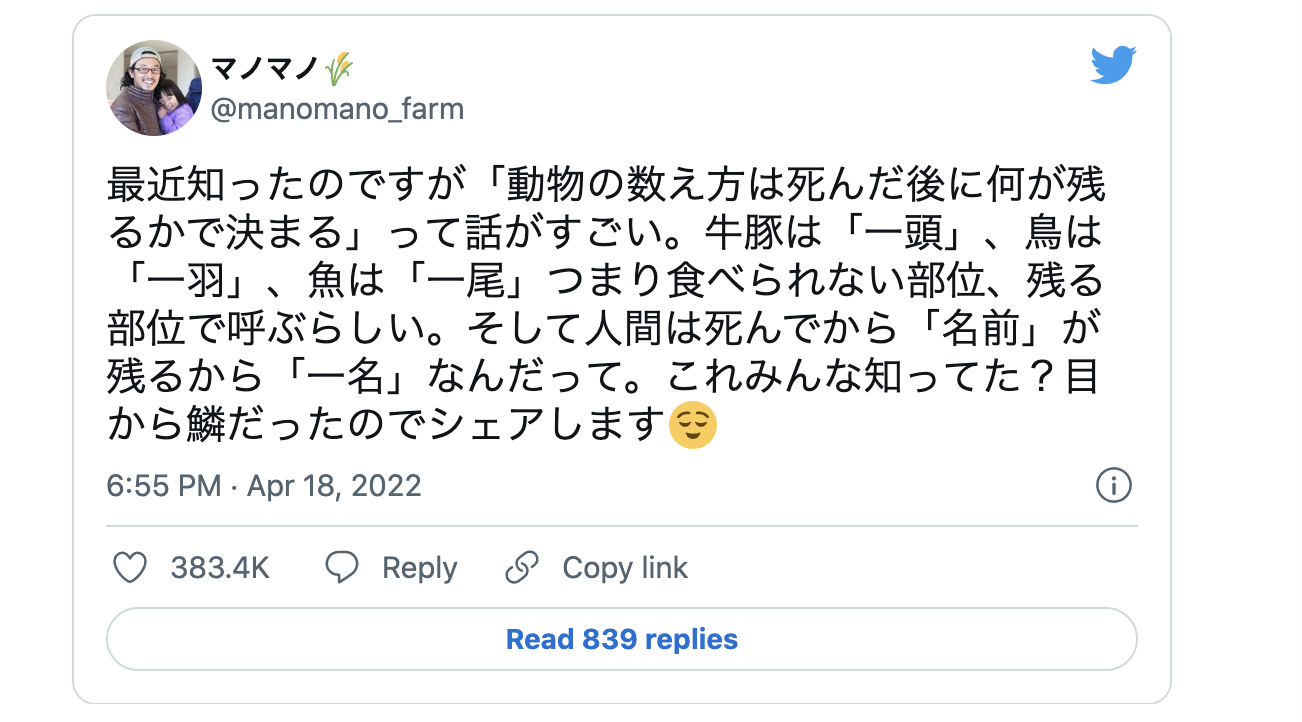There are a lot of differences between English and Japanese that make learning the latter incredibly difficult.
Take the way that animals and people are counted, for instance. In English, you’d simply pop the number in front of the subject — “one cow”, “one bird”, “one person” and so on. But in Japanese, you have to attach a unique word to the number, depending on what the subject is. This requires study, practice, and patience, as around 500 counters exist in Japanese.
Why do these counters exist, and how can you remember them? It’s a question that’s plagued not only students of the language for years, but Japanese people themselves, who are often as puzzled as the rest of us when asked about them.
However, Japanese Twitter user Mano Mano (@manomano_farm) recently shared a reason behind some of the counters for animals and people, and after sharing it online it blew everyone’s minds, earning over 383,000 likes from people who couldn’t believe they’d never made the connection before.
Are you ready to connect the dots behind the language conundrum? Prepare to have your mind blown as you read the translation of the below tweet, which will change the way you think about Japanese counters forever.
“An amazing thing I recently discovered is that ‘How to count animals is dependent on what remains after death’.
Cows and pigs are counted as “一頭” (“itto”), birds are counted as “一羽” (“ichiwa”), and fish are counted as “一尾” (“ichibi”).
In other words, the counter is named after the part that’s not eaten or the part that remains.
And since humans leave behind their “名前” (“namae” or “name”) after they die, the counter for people is “一名” (ichimei).
Did you all know this? The scales have fallen from my eyes so I’m sharing it.”

The scales certainly fell from our eyes too, as it did for thousands of other people around Japan upon hearing this revelation.
So let’s unpack some of the details from the tweet.
When Mano Mano says “Cows and pigs are counted as “一頭” (“itto”)“, this is the counter for one animal, as it has the kanji for “one” (“一”) in front of the kanji counter. That’s the case for all the counters mentioned, and if you were to describe more than one animal, you would change that number accordingly.
However, the really interesting part comes with the counter itself. The kanji used to count cows and pigs (and other large animals like elephants and tigers) is “頭“, which is the kanji for “head”. Some people believe this counter originates from the end of the Meiji era (1868-1912), when Japan adopted the Western style of counting livestock by the head. However, the skulls of these large animals also invoke impactful imagery that are synonymous with the remains of giant animals.
Taking a look at the other mentions in the tweet, the counter for birds is “羽“, which is the kanji for “wing“, while the counter for fish is “尾” (“tail“). When you think about it, one of the most distinguishing features of a fossilised bird skeleton is the wings, and when it comes to fish, people often leave the tail behind, so you’d be able to count how many fish you’ve eaten by counting the tails.
Of course, there are exceptions to the rule, as there always have been — take rabbits, for instance, which use the “羽” counter despite not having wings. There are theories for these discrepancies too, though, with some saying the rabbit counter came about because monks weren’t allowed to eat quadrupeds for religious reasons, so counting rabbits’ ears as “wings” allowed them to get around that fact.
The most poetic takeaway from Mano Mano’s tweet, though, is the notion that all humans leave behind is their name. This is particularly poignant in Japan, where people are given a new name after they die, to avoid them returning to this world when their former name is spoken.
The theory that counters are connected to what an animal or person leaves behind is an intriguing one that provides us with a lot of food for thought. It’s certainly a handy tool to help us remember some of the counters and how to identify them, which is much needed when there are still so many more counters in the language to master.
Source: Twitter/@manomano_farm via Hachima Kiko
Read more stories from SoraNews24.
-- Counting in Japanese just became a whole lot easier with this handy infographic
-- Haku is…Chihiro’s dead brother? Studio Ghibli fans blown away by Spirited Away theory
-- We know it’s hard, Super Mario fans, but please resist the urge to punch this Tokyo Station sign
- External Link
- https://soranews24.com/2022/05/23/why-are-there-different-counters-for-animals-and-people-in-japanese/
 Take our user survey and make your voice heard.
Take our user survey and make your voice heard.















7 Comments
Login to comment
shogun36
because Japanese people want even the simplest things as complicated as humanly possible.
so instead of adapting and just use the simple system of 1,2,3, to universally count things, they keep the confusing outdated ways, just because.
AramaTaihenNoYouDidnt
...as I question, why Japan carries three (3) writing systems to end up with the same definition.
nero
Next up : why are there different pronouns for male and female in Japanese ?
albaleo
Right. They should follow the simplistic approach of the English language. Consistent spelling (tough, through, bough, though). Consistent plurals (cats, oxen, children, geese, haddock). Consistent verb past tenses (walked, spoke, clung, swam, won).
Pukey2
Sorry to spoil things but these counters exist in the much older language called Chinese.
browny1
All languages have peculiarities deemed strange by some others.
And since we're considering animals, take for example the English custom of using collective nouns for groups of animals.
Some very common ones include A Herd of Elephants; a Pride of Lions; a Flock of Sheep (and a Flock of Birds?????); a Swarm of Bees and a Swarm of Rats; a School of Fish but a Pod of Dolphins; a Pack of Dogs and a Pack of Mules??? and on and on and on. What's wrong with just a good old fashioned term like "a Group of..." - keep it simple ay? Japanese people have asked me why? And I answer because it's so.
And while not to anywhere the same extent, counter words do also exist in English such as 2 slices of bread; 2 cups of coffee; 2 pairs of socks or 2 dozen or 1/2 dozen etc.
And while not ok for the purists if all else fails with counting in Japanese, you can revert to i-ko; ni-ko to count things or hitotsu; futatsu etc.
Strangerland
This is pretty silly. Language evolves mate, there isn't a planning committee sitting around deciding that they're going to structure the language in a particular way. The committee to decide English would be pretty stupid if that were the case.